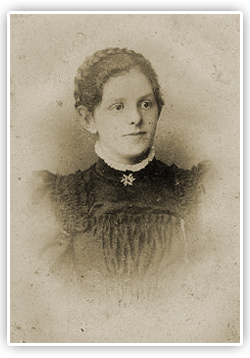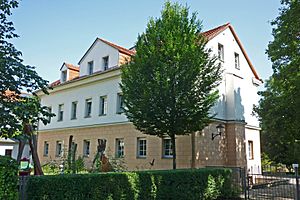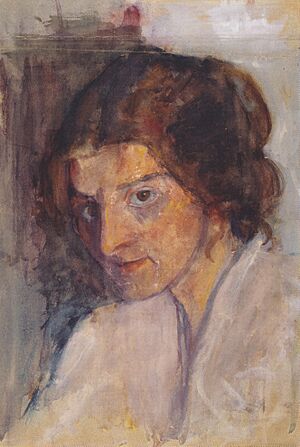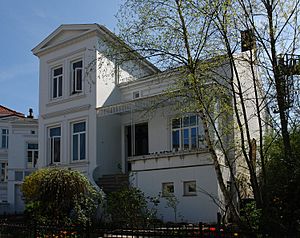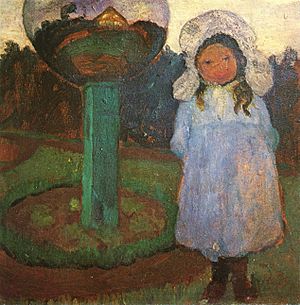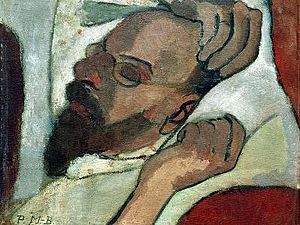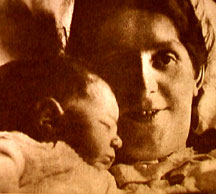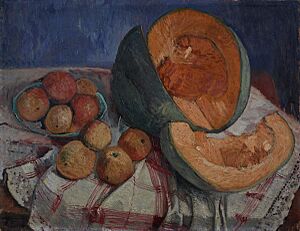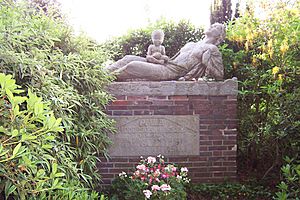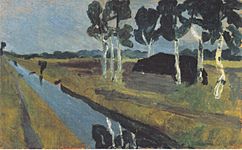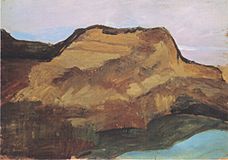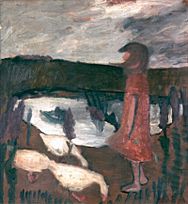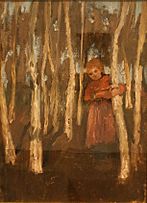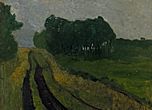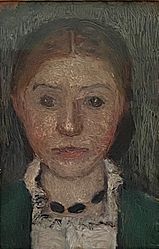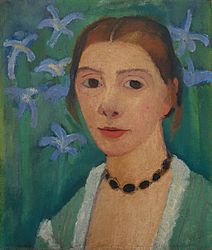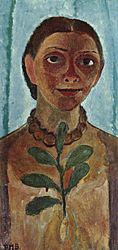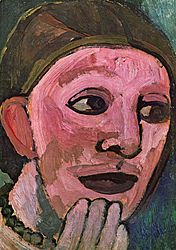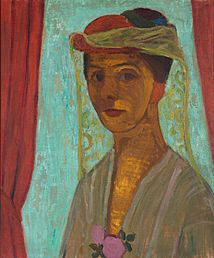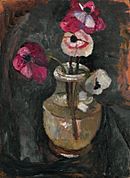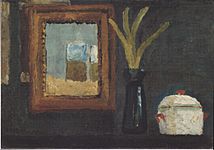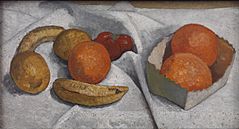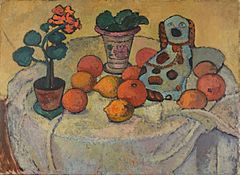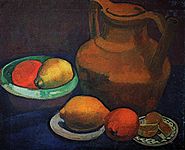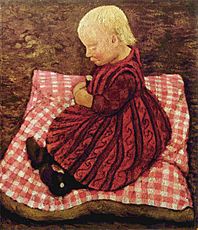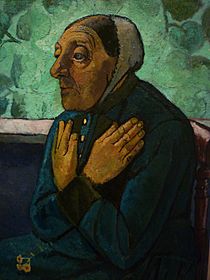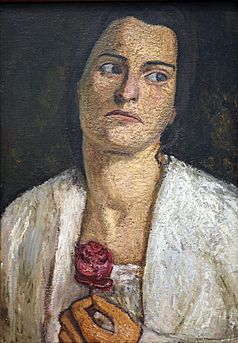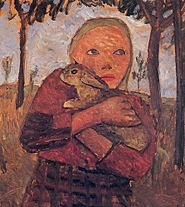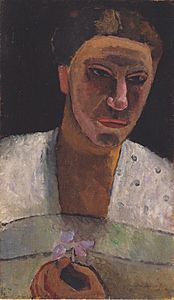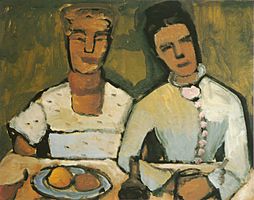Paula Modersohn-Becker facts for kids
Quick facts for kids
Paula Modersohn-Becker
|
|
|---|---|
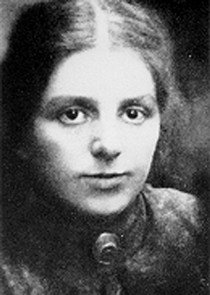
Paula Modersohn-Becker, year unknown
|
|
| Born |
Minna Hermine Paula Becker
8 February 1876 Friedrichstadt (Dresden), German Empire
|
| Died | 20 November 1907 (aged 31) Worpswede, German Empire
|
| Nationality | German |
| Occupation | Artist, painter |
| Years active | 1895-1907 |
| Known for | Expressionism |
| Spouse(s) |
Otto Modersohn
(m. 1901) |
| Children | Mathilde Modersohn |
Paula Modersohn-Becker (born February 8, 1876 – died November 20, 1907) was a German painter. She was an important artist of the late 19th and early 20th centuries, known for her unique style called Expressionism.
Her paintings are famous for being very strong and showing real human feelings. She painted many self-portraits of herself. Paula is seen as one of the most important artists in early Expressionism. She created over 700 paintings and more than 1000 drawings in her short career.
She was also the first woman to have a museum just for her art. This museum, the Paula Modersohn-Becker Museum, opened in 1927. Sadly, her career ended when she died at age 31 from a health problem after giving birth.
About Paula Modersohn-Becker
Paula Becker was born in Dresden-Friedrichstadt, Germany. She was the third of seven children in her family. Her father, Carl Woldemar Becker, was an engineer for the German railway. Her mother, Mathilde, came from an old family.
Her parents made sure their children grew up in a home full of culture and learning. Even with these advantages, her family faced some social challenges. In 1888, her family moved to Bremen. Her father got a new job there.
In Bremen, Paula's family met many local artists and thinkers. This is where Paula started to learn how to draw. In the summer of 1892, her parents sent her to England to learn English. While in London, she had her first drawing lessons at St John's Wood Art School.
After returning to Bremen, she studied at a teacher's school from 1893 to 1895. This was what her father wanted. At the same time, she took private painting lessons from a local German painter named Bernhard Wiegandt.
Paula started painting around 1893, when she was 16. She set up her first art studio in her parents' house in Bremen. Today, this house is called Haus Paula Becker and her early studio is still there. From this time, she painted many portraits of her brothers and sisters. She also painted her first self-portrait in 1893.
She finished her teacher's course very well. But it was clear she did not want to be a teacher. In 1896, Paula went to Berlin for a six-week drawing and painting course. She stayed with her mother's family there. After finishing the course, she stayed in Berlin. In February 1897, she joined the first painting class at the Women's Academy.
Paula also used her time in Berlin to visit art museums. She studied the works of German and Italian artists. After these years of study, Paula went back to Bremen. She convinced her family to let her study more at an artist colony. This colony was in the nearby town of Worpswede.
Worpswede Artist Colony
Paula first learned about the Worpswede colony in 1895. This was when artists like Fritz Mackensen, Otto Modersohn, Fritz Overbeck, and Heinrich Vogeler showed their paintings in Bremen's Art Museum. The colony started when some artists moved to the countryside. They did this to protest against the old-fashioned art academy style. They also wanted to save money.
In 1898, Paula joined the Worpswede group as a student of Mackensen. She painted landscapes and scenes of farm life. She painted the local farmers and the northern German countryside. During this time, she became good friends with the sculptor Clara Westhoff and the poet Rainer Maria Rilke.
However, it soon became clear that Worpswede was not right for Paula's fast-growing art style. She wrote in her journal that Mackensen's way of painting people was "not broad enough" for her. Two paintings she showed in Bremen in 1899 were strongly criticized. They had to be removed from the exhibition.
The Worpswede artists stayed with traditional landscape painting. But Paula's art interests were changing. She was looking more towards Paris. This made her feel more and more different from the Worpswede group.
Paris, the Art Capital
At the start of the 20th century, Paris was the center of new art ideas. Many artists felt they had to go there. Paula's close friend, Clara Westhoff, went to Paris in 1899 to study with Auguste Rodin. By December of that year, Paula followed her friend. She had received a small inheritance, which helped her.
In 1900, Paula began studying anatomy at the Académie Colarossi. She also visited museums and galleries to learn about modern French painters. She was very impressed by the paintings of Paul Cézanne and other artists called Les Nabis. These artists used large colored areas in their paintings, like Paul Gauguin.
Paula's painting style changed a lot after seeing these artists in Paris. She moved away from the traditional painting her friends in Worpswede were doing. The new artists inspired her to use simpler shapes and symbolic colors, not just realistic ones.
In April 1900, a big World's Fair opened in Paris. Otto Modersohn, a painter from Worpswede, came to Paris with friends to see it. His sick wife, Helene, had stayed in Worpswede. Sadly, she died while Otto was in Paris. Otto quickly went back to Germany. Soon after, Paula also returned to Worpswede. It was clear to Paula's parents that she and Otto had become close. But their parents' disapproval did not stop them.
Marriage to Otto Modersohn
In May 1901, Paula Becker and Otto Modersohn got married. Otto was 11 years older than Paula and had a young daughter named Elsbeth. For the next two years, Paula tried to be a wife, a homemaker, and a stepmother, while also working on her art.
She set up a small studio on a nearby farm. She went there to paint for several hours each day. During this time, she created many paintings of children. These include Girl in the Garden Next to a Glass Sphere (1901–2) and Child with Goldfish (1907).
She managed this difficult balance for two years. Then, in 1903, she returned to Paris for two months with Otto. She spent most of her time drawing at the Louvre museum. She also visited Auguste Rodin and studied Japanese art. She met painters like Pierre Bonnard and Édouard Vuillard.
In February 1905, Paula went back to Paris again. Otto came to visit her for a short time. Together, they saw Paul Gauguin's paintings. After this visit, Paula realized that Otto did not like modern artists like Matisse, who fascinated her. She took drawing classes at the Académie Julian. But she also realized that she had already found her own painting style.
After returning to Worpswede, she focused on still life paintings. Before 1905, she had painted only ten still lifes. But from 1905 to 1907, she painted almost 50. For the next two years, she and Otto lived mostly apart. The year 1906 was very productive for her art. She spent most of it in Paris. During her stays in Paris in 1905 and 1906, she lived in her studio. There, she painted portraits of Clara Westhoff and Rainer Maria Rilke.
1906: "I am becoming somebody"
In a letter to Rilke in 1906, Paula wrote: "And now, I don't even know how I should sign my name, I'm not Modersohn and I'm not Paula Becker anymore either." Less than a month later, she wrote to her husband from Paris: "try to get used to the possibility of the thought that our lives can go separate ways."
In 1906, Paula Modersohn-Becker left Worpswede and her husband, Otto. She moved to Paris to focus on her art career. In her journal, she wrote: "Now I have left Otto Modersohn and am standing between my old life and my new life. I wonder what the new one will be like."
Even though her sister and mother did not approve of her leaving Otto for Paris, this move helped her art a lot. During this time, she created her most important and highly praised works. She felt very excited and happy about these paintings. In May 1906, she wrote to her older sister: "I am becoming somebody – I'm living the most intensively happy period of my life."
Final Year and Death
In 1907, Paula returned to her husband in Worpswede. She had often written about her love for him. But she also wrote about needing to delay having children to focus on her art. She was worried about painting while raising a child. Her diary shows she planned to have a painting career by age thirty, then have children.
Her daughter Mathilde (Tillie) Modersohn was born on November 2, 1907. Paula and Otto were very happy. After the birth, Paula felt pain in her legs. She was told to stay in bed. When the doctor came back on November 20, he told her to get up. She walked a few steps, then sat down. She asked for her baby to be placed in her arms. She complained of leg pain and then died, saying only "What a pity."
Paula's death was likely caused by a blood clot (DVT). This is a problem that can happen after childbirth, especially when women stay in bed for a long time, which was common back then. A clot likely formed in her leg. When she moved, it broke off and caused her death within hours.
She was buried in the Worpswede Cemetery.
Painting Style
Paula Modersohn-Becker learned to paint in the styles of realism and naturalism. Her work also had a clear simplicity of form.
She created a special texture in her paintings by scratching into the wet paint. She used this technique throughout her short career. She painted with tempera and oil paints. She used a limited range of colors, like zinc white, cadmium yellow, and ultramarine. Later, she moved towards Fauvism, a style that uses strong, bright colors. You can see Fauvist influences in works like Poorhouse Woman with a Glass Bottle.
Artistic Influences
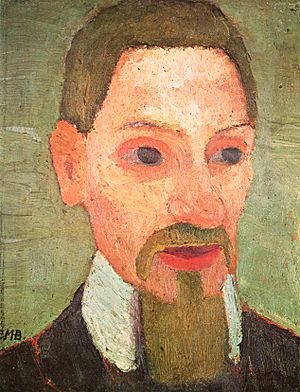
Some of Paula Modersohn-Becker's self-portraits may have been influenced by the Pre-Raphaelite painter Dante Rossetti. These include Self-portrait with a bowl and a glass (c.1904) and Self-portrait with amber necklace (1906).
She often visited art exhibitions. She was especially interested in the work of Paul Cézanne. Other Post-Impressionist artists also influenced her greatly. These included Vincent van Gogh and Paul Gauguin.
Her Influence on Others
Paula Modersohn-Becker may have influenced some of Picasso's paintings. This idea is suggested by Diane Radycki in her book about the artist from 2013.
Legacy
In 1899, Clara Westhoff made a sculpture of Paula Modersohn-Becker. She said it was a symbol of their friendship and shared love for art. In 1908, Rainer Maria Rilke wrote a famous poem called "Requiem for a Friend" to remember Paula.
Paula was not widely known when she died young. She sold few paintings during her lifetime. It was only because of art shows held in the years after her death that collectors learned about her. Then, they started to buy her paintings.
First Museum for a Woman Artist
In 1927, a businessman named Ludwig Roselius opened the Paula Modersohn-Becker Museum in Bremen. It was designed by Bernhard Hoetger, who knew Paula from Worpswede.
"Degenerate Art"
In 1935, local Nazis criticized the museum's art and building. Roselius ignored them until Hitler himself spoke against his entire Böttcherstraße in September 1936. After Roselius's secretary spoke to Hitler for him, the buildings were allowed to stay. But they were called a monument of "degenerate art."
Even though her museum building survived, Paula's art was still harmed by the Nazis. In 1937, 70 of her paintings were taken from German museums. They were either destroyed or shown as "degenerate art."
The Paula Modersohn-Becker Foundation
Paula's daughter, Mathilde Modersohn (1907–1998), started the Paula Modersohn-Becker Foundation in 1978. To begin the foundation, Mathilde donated more than 50 paintings and 500 drawings. She had inherited these from her mother's art collection. The foundation's goal is to help people learn more about the artist. It does this by researching and listing all her works. It also protects her art.
Paula Becker House
Paula Modersohn-Becker's house in Bremen, where she lived for many years, opened in October 2007. It is now a private art museum and gallery. The Becker family moved from Dresden to Bremen in 1888 and lived in this house. Paula lived there until 1899, when she was 23. She set up her first studio in this house. There was an active art community in Bremen. Through her mother's friends in the art world, Paula became part of this community.
In 2003, Heinz and Betty Thies bought the house, which was run-down. They had it restored in time for the 100th anniversary of the artist's death. At that time, in November 2007, it became a public museum.
Recent Exhibitions
- Making Modernism: Paula Modersohn-Becker, Käthe Kollwitz, Gabriele Münter and Marianne Werefkin (November 12, 2022 — February 12, 2023) Royal Academy of Arts, London
- These are my modern women: Trading Monet for Modersohn-Becker (February 20, 2022 — September 4, 2022) Arp Museum Bahnhof Rolandseck
- Paula Modersohn-Becker (October 8, 2021 — February 6, 2022) Schirn Kunsthalle, Frankfurt
- Paula Modersohn-Becker: An Intensely Artistic Eye (April 8, 2016 — August 21, 2016) Musée d’Art moderne, Paris
- Paula Modersohn-Becker: Art and Life (February 2016 — March 12, 2016) Galerie St. Etienne, New York, NY
- Rebels and Martyrs: the image of the artist in the 19th century (opened June 28, 2006) National Gallery, London (first UK exhibition of Self-portrait at 6th Wedding Anniversary)
Paula Modersohn-Becker was once a little-known artist. But now, her work is becoming more and more popular. Some of her most famous paintings are often shown in art exhibitions around the world.
Gallery
Landscapes
Self-portraits
Still lifes
|
Vase with anemones
(1904) |
Still life with a sugar bowl and hyacinth
in a glass (c. 1905) |
Still life with oranges, bananas, lemon and tomato
(1906) State Art Gallery in Karlsruhe |
Still Life with Oranges and Stoneware Dog
(1906-07) |
Still life with clay jug
(1907) |
Still life with marigolds in front of a landscape
(1907) |
Portraits
|
Elsbeth Modersohn on a red pillow (c. 1904)
|
Old Peasant Woman (c. 1905)
|
Klara Rilke-Westhoff (1905) Hamburger Kunsthalle
|
Elsbeth Modersohn with a rabbit(1905)
|
Lee Hoetger with flower
(1906) |
Lee Hoetger and her sister(1906-7)
|
See also
 In Spanish: Paula Modersohn-Becker para niños
In Spanish: Paula Modersohn-Becker para niños
- Der Blaue Reiter
- Die Brücke
- List of German women artists
- Selfportrait at 6th wedding anniversary


